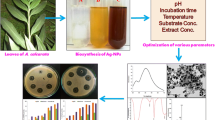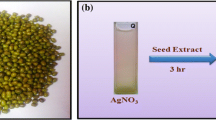Abstract
This present investigated the effect of synthesis temperature on size and shape of silver nanoparticles biosynthesized using aqueous leaf extract Tridax procumbens and their evaluate of antibacterial activities. Silver nanoparticles synthesized at four different temperatures (200 to 500 °C) were characterized by X-ray diffraction (XRD), UV–visible spectroscopy (UV–vis), Fourier transform infrared spectroscopy (FT-IR), photoluminescence (PL) and scanning electron microscopy (SEM) analysis. Silver nanoparticles with crystalline sizes ranging from 18 to 25 nm and narrow size distributions were synthesized. We show that as the temperature rises, the size does not increase in a linear fashion. Micrographs of silver nanoparticles synthesized at 300 °C showed that synthesis temperature affected the sizes and shapes of silver nanoparticles. The FT-IR spectra at different temperatures revealed that the characteristic band for silver at 470 cm−1 became more prominent with increasing temperature as a result of the conversion of precursor into silver nanoparticles. The UV–Vis absorbance of silver nanoparticles shows that as the temperature rises, the absorption peak shifts to a longer wavelength and the bandgap energy decreases. The antibacterial activities of synthesized nanoparticles were determined using a disk diffusion method against gram-positive (B. subtilis and S. aureus) and gram-negative (E. coli and P. aeruginosa) bacteria. Synthesized nanoparticles calcined at 300 °C are more effective at killing E. coli (29 mm) bacteria than other temperatures at 20 µg/mL. Bacterial activity of silver nanoparticles depends on their size, morphology and structural which are affected by their calcination temperature.







Similar content being viewed by others
References
Xu L, Wang YY, Huang J, Chen CY, Wang ZX, Xie H (2020) Silver nanoparticles: synthesis, medical applications and biosafety. Theranostics 10:8996–9031
Alswat AA, Ahmad MB, Saleh TA, Hussein MZB, Ibrahim NA (2016) Effect of zinc oxide amounts on the properties and antibacterial activities of zeolite/zinc oxide nanocomposite. Mater Sci Eng C 68:505–511
Prabhu S, Poulose EK (2012) Silver nanoparticles: mechanism of antimicrobial action, synthesis medical applications, and toxicity effects. Int Nano Lett 2
Alswat AA, Ahmad MB, Saleh TA (2017) Preparation and characterization of zeolite\zinc oxide-copper oxide nanocomposite antibacterial activities. Colloids Interface Sci Commun 16:19–24
Alswat AA, Ahmad MB, Hussein MZ, Ibrahim NA, Saleh TA (2017) Copper oxide nanoparticles-loaded zeolite and its characteristics and antibacterial activities. J Mater Sci Technol 33:889–896
Ibrahim E, Fouad H, Zhang M, Zhang Y, Qiu W, Yan C, Li B, Mo J, Chen J (2019) Biosynthesis of silver nanoparticles using endophytic bacteria and their role in inhibition of rice pathogenic bacteria and plant growth promotion. RSC Adv 9:29293–29299
Guilger Casagrande M, de Lima R (2019) Synthesis of silver nanoparticles mediated by fungi: a review. Front Bioeng Biotechnol 7.
Arya A, Gupta K, Chundawat TS, Vaya D (2018) Biogenic synthesis of copper and silver nanoparticles using green alga Botryococcus braunii and Its antimicrobial activity. Bioinorg Chem Appl 2018:1–9
Shu M, He F, Li Z, Zhu X, Ma Y, Zhou Z, Yang Z, Gao F, Zeng M (2020) Biosynthesis and antibacterial activity of silver nanoparticles using yeast extract as reducing and capping agents. Nanoscale Res Lett 15.
Khan NT, Jameel J (2016) Optimization of reaction parameters for silver nanoparticles synthesis from fusarium oxysporum and determination of silver nanoparticles concentration. J Mater Sci Eng 5:283
Saleh TA (2021) Protocols for synthesis of nanomaterials, polymers, and green materials as adsorbents for water treatment technologies. Environ Technol Innov 24:101821
Saleh TA (2020) Trends in the sample preparation and analysis of nanomaterials as environmental contaminants. Trends Environ Anal Chem 28:e00101
Saleh TA (2020) Nanomaterials: classification properties and environmental toxicities. Environ Technol Innov 20:101067
Bachhav PA, Shroff RM, Shirkhedkar AA (2020) Silver nanoparticles: a comprehensive review on mechanism, synthesis and biomedical applications. Asian J Pharm 10:202
Ivanova N, Gugleva V, Dobreva M, Pehlivanov I, Stefanov S, Andonova V (2019) Silver nanoparticles as multi-functional drug delivery systems. Nanomedicines
Fathi Achachelouei M, Knopf Marques H, Ribeiro da Silva CE, Barthès J, Bat E, Tezcaner A, Vrana NE (2019) Use of nanoparticles in tissue engineering and regenerative medicine. Front Bioeng Biotechnol 7:113
Punnoose MS, Mathew B (2018) Treatment of water effluents using silver nanoparticles. Mater Sci Eng Int J 2:159–166
Masum MMI, Siddiqa MM, Ali KA, Zhang Y, Abdallah Y, Ibrahim E, Qiu W, Yan C, Li B (2019) Biogenic synthesis of silver nanoparticles using phyllanthus emblica fruit extract and its inhibitory action against the pathogen Acidovorax oryzae strain RS-2 of rice bacterial brown stripe. Front Microbiol 10
Singh A, Kaur K, Kaur K, Singh J, Kumar N, Bedi N, Mohinder Singh Bedi P (2021) Silver nanoparticles impregnated wound dressings: recent progress and future challenges, silver micro-nanoparticles—properties, synthesis, characterization, and application
Ikewuchi CC, Ikewuchi JC, Ifeanacho MO (2015) Phytochemical composition of Tridax procumbens, Linn Leaves: potential as a functional food. Sci Nutr 06:992–1004
Syed A, Benit N, Alyousef AA, Alqasim A, Arshad M (2020) In-vitro antibacterial, antioxidant potentials and cytotoxic activity of the leaves of Tridax procumbens. Saudi J Biol Sci 757–761
Muthuvel A, Said NM, Jothibas M, Gurushankar K, Mohana V (2021) Microwave-assisted green synthesis of nanoscaled titanium oxide: photocatalyst antibacterial and antioxidant properties. J Mater Sci Mater Electron 32:23522–23539
Yang X, Du Y, Li D, Lv Z, Wang E (2011) One-step synthesized silver micro-dendrites used as novel separation mediums and their applications in multi-DNA analysis. Chem Commun 47:10581
Bárcena C, Sra AK, Gao J (2009) Applications of magnetic nanoparticles in biomedicine. Nanoscale Magn Mater Appl 591–626
Swain AK (2016) Review on green synthesis of silver nanoparticles by physical, chemical and biological methods. Int J Sci Eng 7:551–554
Muthuvel A, Jothibas M, Mohana V, Manoharan C (2020) Green synthesis of cerium oxide nanoparticles using Calotropis procera flower extract and their photocatalytic degradation and antibacterial activity. Inorg Chem Commun 119:108086
Woo W, Jeong JS, Kim DK, Lee CM, Choi SH, Suh JY, Lee SY, Harjo S, Kawasaki T (2020) Stacking fault energy analyses of additively manufactured stainless steel 316L and CrCoNi medium entropy alloy using in situ neutron diffraction. Sci Rep 10:1350
Saleh TA (2018) Simultaneous adsorptive desulfurization of diesel fuel over bimetallic nanoparticles loaded on activated carbon. J Clean Prod 172:2123–2132
Saleh TA (2015) Nanocomposite of carbon nanotubes/silica nanoparticles and their use for adsorption of Pb(II): from surface properties to sorption mechanism. Desalin Water Treat 57:10730–10744
Al-Zaqri N, Muthuvel A, Jothibas M, Alsalme A, Alharthi FA, Mohana V (2021) Biosynthesis of zirconium oxide nanoparticles using Wrightia tinctoria leaf extract: Characterization, photocatalytic degradation and antibacterial activities. Inorg Chem Commun 127:108507
Anandh B, Muthuvel A, Emayavaramban M (2014) Bio Synthesis and characterization of silver nanoparticles using lagenaria siceraria leaf extract and their antibacterial activity. Int Lett Chem Phys Astron 38:35–45
Muthuvel A, Jothibas M, Manoharan C (2020) Synthesis of copper oxide nanoparticles by chemical and biogenic methods: photocatalytic degradation and in vitro antioxidant activity. Nanotechnol Environ Eng 5:2
Zhang XF, Liu ZG, Shen W, Gurunathan S (2016) Silver nanoparticles: synthesis, characterization, properties, applications, and therapeutic approaches. Int J Mol Sci 17:1534
Saleh TA (2015) Isotherm, kinetic, and thermodynamic studies on Hg(II) adsorption from aqueous solution by silica- multiwall carbon nanotubes. Environ Sci Pollut Res 22:16721–16731
Saleh TA, Tuzen M, Sarı A (2018) Polyamide magnetic palygorskite for the simultaneous removal of Hg(II) and methyl mercury; with factorial design analysis. J Environ Manag 211:323–333
Saleh TA, Naeemullah TM, Sarı A (2017) Polyethylenimine modified activated carbon as novel magnetic adsorbent for the removal of uranium from aqueous solution. Chem Eng Res Des 117:218–227
Satheshkumar M, Anand B, Muthuvel A, Rajarajan M, Mohana V, Sundaramanickam A, Enhanced photocatalytic dye degradation and antibacterial activity of biosynthesized ZnO-NPs using curry leaves extract with coconut water. Nanotechnol Environ Eng, 5:29
Author information
Authors and Affiliations
Corresponding author
Ethics declarations
Conflict of interest
All authors sincerely declare that they have no known competing financial interests.
Additional information
Publisher's Note
Springer Nature remains neutral with regard to jurisdictional claims in published maps and institutional affiliations.
Rights and permissions
About this article
Cite this article
Jayanthi, P.J., Punithavathy, I.K., Jeyakumar, S.J. et al. Influence of temperature on the structural, optical, morphological and antibacterial properties of biosynthesized silver nanoparticles. Nanotechnol. Environ. Eng. 7, 883–891 (2022). https://doi.org/10.1007/s41204-022-00235-3
Received:
Accepted:
Published:
Issue Date:
DOI: https://doi.org/10.1007/s41204-022-00235-3




